Temples: Difference between revisions
No edit summary |
|||
| Line 45: | Line 45: | ||
These social service once provided through free will contributions made in the sacred temple areas over the altars constructed by priestly class who saw to their fair distributions became the centers of a socialist state as the [[Republic]] declined and imperial powers rose to prominence. The faithful and [[Freewill offerings]] of ancient society had become contractual bands that bound the members of that society under the authority of the state to the [[Imperial Cult of Rome]]. | These social service once provided through free will contributions made in the sacred temple areas over the altars constructed by priestly class who saw to their fair distributions became the centers of a socialist state as the [[Republic]] declined and imperial powers rose to prominence. The faithful and [[Freewill offerings]] of ancient society had become contractual bands that bound the members of that society under the authority of the state to the [[Imperial Cult of Rome]]. | ||
| Line 72: | Line 64: | ||
== Temple of Quirinus == | |||
Quirinus was an epithet of Janus, Janus Quirinus, derived from the Sabine word ''quiris'' or "spear." Quirinus was the personification of all Quirites who were the brave ''men of the oaken spear'' who defended the nation as a noble people's militia. Over the century the rituals and rites, as well as the name of these deified virtues, celebrated heroes and heroines who sacrificed themselves and their wealth for the good of the people. They were often commemorated with festivals and feasts of sharing for even ancient peoples knew that only in regular sacrifice of self does a society remains sustainable. | |||
The sacrifices of society must be free if society is to remain free. | |||
'''Quirinus, sacellum''': an ancient shrine on the Quirinal, near the porta Quirinalis. A statue was dedicated to Augustus in the temple as the Savior and [[Apotheos]] of Rome. '''Quirinus, aedes''', a temple on the Quirinal hill, one of the Seven Hills of Rome. The temple was one of the oldest in Rome. | |||
== Temple of Venus and Roma == | |||
'''The Temple of Venus and Roma''' — in Latin, Templum Veneris et Romae — is thought to have been the largest temple in Ancient Rome. King Herod also built temple for the same function as his [[Temple in Jerusalem]] including King Herod's Temple to Roma and Augustus. | '''The Temple of Venus and Roma''' — in Latin, Templum Veneris et Romae — is thought to have been the largest temple in Ancient Rome. King Herod also built temple for the same function as his [[Temple in Jerusalem]] including King Herod's Temple to Roma and Augustus. | ||
== Temple of Diana == | |||
[[File:Ephesus.jpg|right|250px|thumb|Christians were accused of robbing the '''Temple of Diana in Ephesus'''. How?]]'''Temple of Diana in Ephesus''' - Christians were accused of robbing the Temple of Ephesus. It served as an underwriter for social welfare insurance and a central bank for at least the 127 countries which built the temple. | [[File:Ephesus.jpg|right|250px|thumb|Christians were accused of robbing the '''Temple of Diana in Ephesus'''. How?]]'''Temple of Diana in Ephesus''' - Christians were accused of robbing the Temple of Ephesus. It served as an underwriter for social welfare insurance and a central bank for at least the 127 countries which built the temple. | ||
| Line 86: | Line 89: | ||
“The temple was so rich and prosperous that it became, with the temple in Jerusalem, one of the world’s first banks.”<Ref>Trinity College of Biblical Studies</Ref> Read [http://www.hisholychurch.org/media/books/TKC/TKCi9-2InvestinDiana.php Investing in Diana]. | “The temple was so rich and prosperous that it became, with the temple in Jerusalem, one of the world’s first banks.”<Ref>Trinity College of Biblical Studies</Ref> Read [http://www.hisholychurch.org/media/books/TKC/TKCi9-2InvestinDiana.php Investing in Diana]. | ||
== Temple of Neptune == | |||
'''Temple of Neptune''' (Hera)at Paestum | '''Temple of Neptune''' (Hera)at Paestum | ||
| Line 92: | Line 98: | ||
Minerva, the Roman goddess of wisdom peace and the arts which is why Guilds of Smith donated to the construction of her buildings. | Minerva, the Roman goddess of wisdom peace and the arts which is why Guilds of Smith donated to the construction of her buildings. | ||
Parthenon's double function as a religious temple and a treasury but "religion" was what you did to care for the needy of society. | |||
A back room in temples was called the opisthodomos. It usually served as a storage space for cult equipment which included means to weigh and measure offerings and stamp coins or even change the content of coins. These rooms also included vaults to hold the temple treasury. | |||
The opisthodomus of the Athenian Parthenon housed the treasury of the ''Delian League''. Pronaos, anticum or prodomus which were often open areas and opisthodomos were often closed off from the peristasis (four-sided porch or hall of columns) by wooden barriers or fences. | |||
== Temple of Artemis == | == Temple of Artemis == | ||
Revision as of 04:00, 27 February 2016
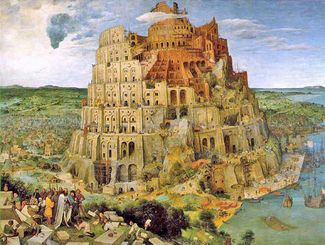
Temples of the mind
Can the Church be a temple or a temple a Church?
Were temples government buildings?
Are you a temple?
Or do you depend upon the temples made by hands?
The English word "temple" derives from Latin templum, which was originally not the building itself, but a sacred space surveyed and plotted ritually. Today we associate a temple with the buildings that have survived through history.
What were their real purpose? Are other buildings like these temples serving government purposes or religious purposes?
Or are they one in the same?
What is the difference between public and private welfare?
What were they doing in what we call pagan temples?
And who is doing the same thing now?
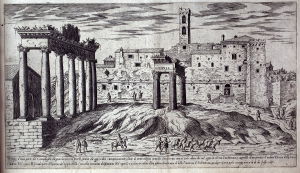
Temple of Saturn
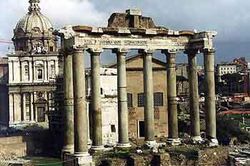
- "This unique Temple of Saturn constitutes one of the oldest cult places of Rome. Before its foundation there had been a very ancient altar and temple itself was said to have been founded in around 497 BC." [1]
The Temple of Saturn contained the treasury or "aerarium". This is where the Roman Republic vaulted its reserves of gold and silver. It also contained the state archives until they were transferred to the nearby Tabularium. Other official scale and instruments for the weighing precious metals and items like official insignia were stored there by the government for safe keeping. A flamen was a priest assigned to the oversight of these important governmental services. The temple's podium included a covered area for posting government bills and announcements.
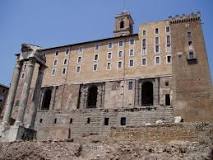
The first building for maintaining public records in Rome, including the law, was erected under the protection of the temple of Saturn, as early as 509 B.C. but was possibly burned by the Gauls in 309 B.C. Other buildings were used until 78 B.C. when they built the great Tabularium, on Capitoline Hill, below the Temple of Jupiter.
Temple of Saturn - Bureau of Vital Statistics. Parents where required to get newborns registered (birth certificate) within 30 days with the government. It was at the Temple of Saturn this government certification was kept. The reason was simple. It was so that everyone would know when the children reached the age to receive benefits of the Patronus of Rome.
- The "Aerarium Stabulum" or treasure-house was the public treasury in Rome. It was used to store monies and record accounts of the state finances, copies of public laws engraved on brass plates, a record of the decrees of the Senate and other public registries, letters of credence from foreign diplomats and even the standards of the legions. These public treasures, records and accounts were all deposited on the eastern slope of the Capitoline hill within the temple of Saturn at the Forum Romanum containing several important ancient government buildings at the center of the city of Rome.
- The "Aerarium sanctius" was a special reserve fund, also in the Temple of Saturn. It was maintained by free contributions of Generals but eventually by a 5% tax on the value of all manumitted slaves. This source of revenue was established by a lex Manila in 357 B.C. and was the equivalent of an unemployment tax. The sanctius meant it was not to be touched except in dire circumstances.
These social service once provided through free will contributions made in the sacred temple areas over the altars constructed by priestly class who saw to their fair distributions became the centers of a socialist state as the Republic declined and imperial powers rose to prominence. The faithful and Freewill offerings of ancient society had become contractual bands that bound the members of that society under the authority of the state to the Imperial Cult of Rome.
Temple of Jupiter
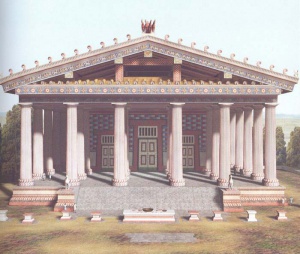
The Temple of Capitoline Jupiter which was the symbol of the sovereignty and power of Rome was dedicated to the Optimus Maximus Jupiter, together with the other two divinities that made up the Capitoline triad - Juno and Minerva. The "Tribunes" "most often conducted their legislative assemblies at the Temple of Jupiter Optimus Maximus, thereby implicitly invoking Jupiter's role as patron of the Republican political system..."[2] The building housed important records, books and ceremonial items and included a chamber below the main hall which was used to store sacrificial offerings of Qorban and other government funds including the treasury of the city. Only the priests in charge of administering these funds were allowed into these chambers and vaults.
Knowing that at the Temple of Jupiter the Tribunes not only conducted their legislative assemblies but it housed important records, books and the social welfare funds including the treasury of the city within the chambers and vaults of that temple could enhance our understanding of the Christian conflict.
Archaic Triad of Rome consisted of Jupiter, Mars and Quirinus.
The Temple of Mars
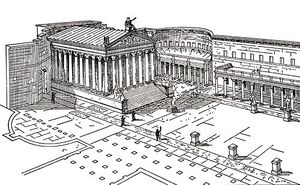
In The Temple of Mars Ultor Augustus established the "Aerarium militare" in AD 6 as well as the fiscus[3]. It was a military treasury which contained the funds for veterans' retirement benefits. Under Augustus it was largely endowed by the emperor[4] himself and supported by the proceeds of new taxes, an 5% tax on inheritances and 1% on auction-sales. It replaced the aerarium Saturni, and eventually became the municipal treasury of the city of Rome.
Temple of Quirinus
Quirinus was an epithet of Janus, Janus Quirinus, derived from the Sabine word quiris or "spear." Quirinus was the personification of all Quirites who were the brave men of the oaken spear who defended the nation as a noble people's militia. Over the century the rituals and rites, as well as the name of these deified virtues, celebrated heroes and heroines who sacrificed themselves and their wealth for the good of the people. They were often commemorated with festivals and feasts of sharing for even ancient peoples knew that only in regular sacrifice of self does a society remains sustainable.
The sacrifices of society must be free if society is to remain free.
Quirinus, sacellum: an ancient shrine on the Quirinal, near the porta Quirinalis. A statue was dedicated to Augustus in the temple as the Savior and Apotheos of Rome. Quirinus, aedes, a temple on the Quirinal hill, one of the Seven Hills of Rome. The temple was one of the oldest in Rome.
Temple of Venus and Roma
The Temple of Venus and Roma — in Latin, Templum Veneris et Romae — is thought to have been the largest temple in Ancient Rome. King Herod also built temple for the same function as his Temple in Jerusalem including King Herod's Temple to Roma and Augustus.
Temple of Diana
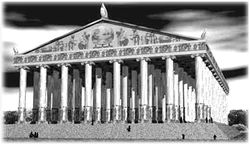
Temple of Diana in Ephesus - Christians were accused of robbing the Temple of Ephesus. It served as an underwriter for social welfare insurance and a central bank for at least the 127 countries which built the temple.
Were Christians actually bank robbers?
Or was something lost in translation?
The great historian of the period, Aristeides, defined Ephesus as "Asia's greatest center of trade and banking".[5]
- "The temple possessed valuable lands; it controlled the fisheries; its priests were the bankers of its enormous revenues. Because of its strength the people stored there their money for safe-keeping; and it became to the ancient world practically all that the Bank of England is to the modern world."[6]
“The temple was so rich and prosperous that it became, with the temple in Jerusalem, one of the world’s first banks.”[7] Read Investing in Diana.
Temple of Neptune
Temple of Neptune (Hera)at Paestum
Minerva is one of three virgin goddesses along with Artemis and Hestia, known by the Romans as Diana and Vesta.
Minerva, the Roman goddess of wisdom peace and the arts which is why Guilds of Smith donated to the construction of her buildings.
Parthenon's double function as a religious temple and a treasury but "religion" was what you did to care for the needy of society.
A back room in temples was called the opisthodomos. It usually served as a storage space for cult equipment which included means to weigh and measure offerings and stamp coins or even change the content of coins. These rooms also included vaults to hold the temple treasury.
The opisthodomus of the Athenian Parthenon housed the treasury of the Delian League. Pronaos, anticum or prodomus which were often open areas and opisthodomos were often closed off from the peristasis (four-sided porch or hall of columns) by wooden barriers or fences.
Temple of Artemis
Pliny describes the temple as 377 feet (115 meters) long and 180 feet (55 meters) wide, made almost entirely of marble, making its area about three times as large as the Parthenon.
Prytanea or Vestal Temples
Prytaneum was a Court where the Senates or Council of a city met. as did the Sanedrim in the Temple of the Jews.
It was used in the performance of the obligations that belonged to the chief Magistrates of the City or State government.
These rulers often took on the responsibility of the Pontifex Maximus to insure the honesty of those who performed the charitable care of society in areas of health, education and welfare. They were overseers of the public trust like we see in the instances of Melchizedeck, Abraham or David as the overseer of the Porters of the temple and of course Jesus and the money changers.

Related to the Annona was the Alimenta, an early form of welfare instituted by Trajan that used public funds rather than just private donations to feed poor children. "ALIMENTA" like the Bread and circuses was designed to feed the poor on a regular basis with bread, meats and fruit and win the popular support of the masses with benefits through the public supported temples.
Temple of Juno Moneta
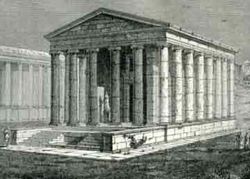
The Temple of Juno Moneta (Latin: Templum Iunonis Monetæ) was an ancient Roman temple that stood on the Arx or the citadel on the Capitoline Hill overlooking the Roman government Forum. The word Money is from a Middle English word from Old French moneie, from Latin moneta ‘mint, money’. It was an original title of the goddess Juno, in whose temple the money of Rome was minted. In addition, it was the place where the books recording the legal opinions of the magistrates and judges, who were the gods of Roman Courts were deposited. These gods decided what was good and what was evil and the other Weightier matters of society.
Temple of Ceres
In ancient Roman religion, Ceres was by myth the personification of a goddess of agriculture, grain crops, fertility and motherly relationships. The free bread or grain dole was distributed from her Temple of Ceres which was a part of the Public religion of Rome Christians came into conflict with at the time of Saturninus whose political platform lowered the price of grain. Julius Caesar reformed the dole and Augustus lowered the number of recipients to 200,000 but this Covetous Practices was already taking its toll upon the moral integrity and financial stability of society.
Temple of Concord and Castor
In the Temple of Concord and Castor there were rooms cut in solid rock used as a repository of the treasury where it is said "that private citizens also deposited their money in the temple for safekeeping".[8] There was a statue to Salus in the temple of Concordia. Salus, (Latin: salus, "safety", "salvation", "welfare"[9])was the goddess of safety and well-being. including welfare, health and prosperity, of both the individual and the state.
Temples of Religion
Temples were places where public religion and worship occurred but to understand what that means you must understand what Religion was supposed to be.
Public religious ceremonies took place outdoors, and not within the temple building. Some ceremonies ended with a temple or shrine, where a ritual object might be stored and brought out for use, or where an offering would be deposited. Sacrifices, like animals, would take place at an open-air altar within the templum and were eaten at festivals or distributed to the poor as a part of the public social welfare in the case of public religion.
The real Church established by Christ must be the temple of Pure Religion. The temple of God is made of living stones who care about one another in the love of Christ. They function through charity while the Temples of the world force the contributions of the people under the authority of men like Cain and Nimrod.
The Christian conflict with the people who persecuted them in the early days of the Church was mostly over their system of social welfare which was managed through their temples like Ephesus, Temple of Saturn and the Parthenon.
Romans had superstitions but they were practical people. They did not build without a purpose an a plan. Saturn was the god of agriculture. Agriculture needs calendars and records.
Temple of Nebo
Parents sent their children to the Temple of Nebo to receive their public education. Nebo was the Mesopotamian god of education, wisdom and oracles.
Eventually when the Roman State became the Benefactors of the people through its systems of welfare parents where required to register newborns (birth certificate) within 30 days at the Temple of Saturn so that everyone would know when the children reached the age to receive benefits.
As Romans began to dominate a large part of the Greek world, Rome's Conscripted fathers there were given the same divine honours as were Hellenistic rulers. The people believed there was a spiritual connection to a god that attributed success to their heroes and saviors.
This hero worship may seem innocent like the adoration given to celebrities today. They did some time save society as in the case of Scipio Africanus, victor over Hannibal, whose death mask was stored in the temple of Jupiter; an by Ennius epitaph said that he had ascended to Heaven. It was believed by many that he had been inspired by prophetic dreams, and was himself the "son of Jupiter". This did not suggest just that he was begotten as much as adopted or was spiritually connected or guided by that god's character.
The temples besides providing functions of social welfare were also museums and place to commemorate the past. Several men were viewed as military or political saviors. In the 70s BC, Roman loyalist greeted the proconsul Metellus Pius as a savior, burning incense "as if to a god" for putting down the Lusitanian rebellion in Spain. Octavius was hailed as savior and given the title of Augustus as he marched into Rome after the civil war that made him Emperator, commander in chief of the army and navy.
Gaius Octavius had restored the pax deorum (divinely ordained peace) and was accepted as the Augustus, meaning "majestic," "the increaser," or "venerable". This position of adoration and respect evolved within the Senate. He was the princeps or primus inter pares (first among equals). He was to curb to the corruption of the ambitious and regulate rivalries that had led to the civil wars. Augustus' principate was made him censor and pontifex maximus. His expanded wealth due to the spoils of war allowed him to support the charitable welfare through the temples which increased his popularity.
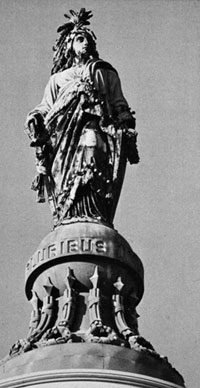
The mos maiorum [10] It is the core concept of Roman traditionalism which had rose to greatness through the network of hearths who voluntarily came together to support the Republic.
The importance of the Roman Familia was symbolized by Vesta the virgin goddess of the hearth, home, and family in Roman religion. But that religion was the traditional custom of families helping and caring for families. Volunteerism in the practice of the Social Virtues was the core to the success of the Roman society.
As individual responsibility waned during the rise of a more socialist state and mutual love of neighbor declined during the rise of power and centralization of government authority the noble hearts of society were replaced by more selfish and self-serving spirit. History repeats itself.
More than two thousand years ago among the ancient Romans the people honored the Goddess of Freedom. She was called Libertas, the Latin word for Freedom. Libertas signified both personal and social liberty, freedom of action, independence, rights, and freedom from restraint.personal and social liberty. This Goddess of Freedom merged with the chief Roman God Jupiter, in the form of Jupiter Libertas, whose feast was celebrated on April 13.
Bread and Circuses
We see the temples were not only store houses of birth and family records but also funds that financed public works from construction to soldiers of war and their pensions.
The gifts given by Augustus was unprecedented in Roman history but so was his wealth after defeating and confiscating so much property of his opponents during the civil war.
A congarium or congiary was a vessel that was used to hold a measure of wine or oil. A congius was equal to six sextarii.
Tiberius gave a congiarium of 72½ denarii (300 sesterces) to each citizen. Caligula gave the same amount of three hundred sesterces on two occasions. Nero, whose congiaria were the earliest known examples represented on medals, gave four hundred.
It became a term for liberal donations to the people and to the soldiers including oil, wine, grain, or money, or other things.
Trajan had a practice of giving extravagant congiaria to the people of Rome. His first congiarium, in 99, was probably no larger than that of Nerva (75 denarii per person), but after each Dacian War distributions of money amounted to 650 denarii per person.
Hadrian treated the Roman people in the same way.
From the Nerva ailmenta Trajan ordered distributions to orphans and needy every month by the “praefecti alimentorium”.
Under Pliny the younger welfare increased the number of healthy children when age limits were raised to 18 for boys and 12 for girls.
Marcus Cornelius Fronto, Roman grammarian, rhetorician and advocate and suffect consul of 142 AD said:
- I consider it good policy that the prince did not neglect the theater or the circus and arena, as he well knew that there are two things which the Roman applaud especially—the distribution of grain, and games. The neglect of the important thing (free bread) causes great harm, of the frivolous thing (circuses) greater hatred—the crowd hungering more for games than for bread, because by the gift to the people (congiarium)] only those who are authorized to receive the grain will be gratified, while by the games the whole population is pacified.[11]
This was all a part of the Roman welfare system supported by taxes and tribute. Judea began following this social model in earnest with Herod the Great. His system for the Jew would include Baptism, scribes to do the accounting and a Corban that would make the word of God to none effect.
Jewish Temples
Temple of Herod - Those baptized into Herod's government went to Herod's temple to receive welfare and social security benefits. More on the two types of baptism.
LISHKAS HAGAZIS
Lishkas Hagazis was known as the Chamber of Hewn Stone It was the top of the Jewish legal system. It was their supreme court building. Here the Sanhedrin, seventy-one judges met. They dealt with the more difficult cases and was the court of final appeal in all matters of Jewish law. They also gave the final approval for a Jewish king to go to war, oversaw the function of the Temple and of course the temple was a government building.
Also read more on how Christians weren't registered in central government of the day.
The Christians depended on a Holy temple made of living stones which was a network of people living by the perfect law of liberty and faith, hope and charity. Those that had shared with those who had true needs.
Religion |
Pure Religion |
Private welfare |
Fleeing Religion |
False religion |
Public religion |
Our Religion |
Christian conflict |
Corban |
Baptism |
Benefactors |
That Word |
Daily ministration |
Modern Christians |
Diocletianic Persecution |
Christians check list |
gods |
Judge not |
Judge |
Fathers |
Deist |
Damnable heresies |
Factions at the altar |
Pharisees |
Sadducees |
Zealot |
Essenes |
Levites |
Messianic Judaism |
Menahem the Essene |
Sanhedrin |
Altars |
Clay and Stone |
Red Heifer |
Golden calf |
Freewill offerings |
Religion |
Pure Religion |
Public religion |
Christian conflict |
Paganism |
Denominations |
Dispensationalism |
Benefactors |
Corban |
Daily ministration |
Calendars |
Cult |
Imperial Cult of Rome |
Guru theories| |
Covet |
Merchandise |
Mark of God |
Mark of Cain |
Mark of the Beast |
Nature of the Beast
Section 666 |
Benefactors |
Biting one another |
Cry out |
Worship |
Church |
Temples |
Religious Orders |
Priests |
Kings and priests |
Hear |
Bible Index |
Network |
Economy |
Spiritual Economics |
Capitalism |
Socialism |
Divers lusts |
Business |
Kingdom Business |
Welfare |
Surety |
Temples |
Temple of Diana |
Temple in Jerusalem |
Seven Men |
Money Audio |
Real Money |
Money can be anything |
Debt Money |
Money as debt quotes |
Bitcoin |
Cashless |
Money |
I paid in |
Commodity money |
Value |
Mammon |
Covet |
Merchandise |
One purse |
Road Map |
Golden calf |
Temples |
Treasury |
Moneychangers |
The Bank of the Golden Calf | Study audio
Seven men |
Reserve fund |
Ephesus |
Tithe |
Sabbath |
Credit unions |
Thy first love |
HHC Money vs Mammon >
>Audio |
Conversion vs Reconversion >
>Audio |
See more Forbidden Definitions
== Footnotes ==
- ↑ Inconsistencies in Greek and Roman Religion: Transition and Reversal in Myth and Ritual. Tome II By H. S. Versnel
- ↑ Public Office in Early Rome: Ritual Procedure and Political Practice. By Roberta Stewart
- ↑ Fiscus, from which comes the English term fiscal, was the name of the personal treasury of the emperors of Rome. The word is literally translated as "basket"
- ↑ Emperator was the Latin title meaning commander in chief and originally a ten year term of office.
- ↑ History of Ephesus
- ↑ from International Standard Bible Encyclopedia, Electronic Database Copyright (c)1996 by Biblesoft
- ↑ Trinity College of Biblical Studies
- ↑ Ancient History pamphlets, Volume 3
- ↑ M. De Vaan Etymological Dictionary of Latin Leyden 2010 s.v.; The Oxford Classical Dictionary 4th ed. London & New York 2012 s.v.
- ↑ "ancestral custom" or "way of the elders," is the unwritten code of Romans derived from respected noble families who established social norms.
- ↑ Fronto, Prim. Hist., p. 249, ed., Barthold Georg Niebuhr.
About the author
Subscribe
HELP US at His Holy Church spread the word by SUBSCRIBING to many of our CHANNELS and the Network.
The more subscribers will give us more opportunity to reach out to others and build the network as Christ commanded.
Join the network.
Most important is to become a part of the Living Network which is not dependent upon the internet but seeks to form The bands of a free society.
You can do this by joining the local email group on the network and helping one another in a network of Tens.
His Holy Church - YouTube
https://www.youtube.com/user/hisholychurch
Bitchute channel will often include material that would be censored.
https://www.bitchute.com/channel/o6xa17ZTh2KG/
Rumble Channel gregory144
https://rumble.com/user/gregory144
To read more go to "His Holy Church" (HHC) https://www.hisholychurch.org/
Brother Gregory in the wilderness.
https://www.youtube.com/channel/UCJSw6O7_-vA4dweVpMPEXRA
About the author, Brother Gregory
https://hisholychurch.org/author.php
PreparingU - YouTube
https://www.youtube.com/channel/UC9hTUK8R89ElcXVgUjWoOXQ
Facebook
https://www.facebook.com/HisHolyChurch
